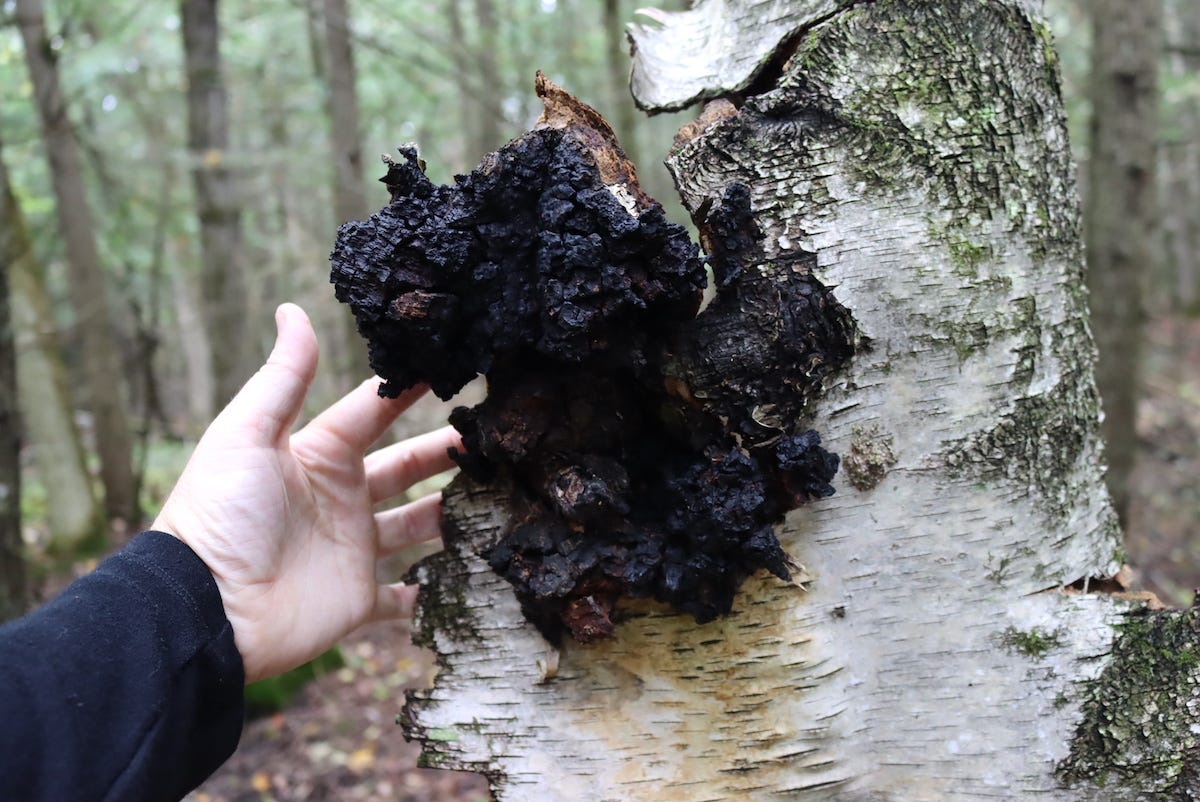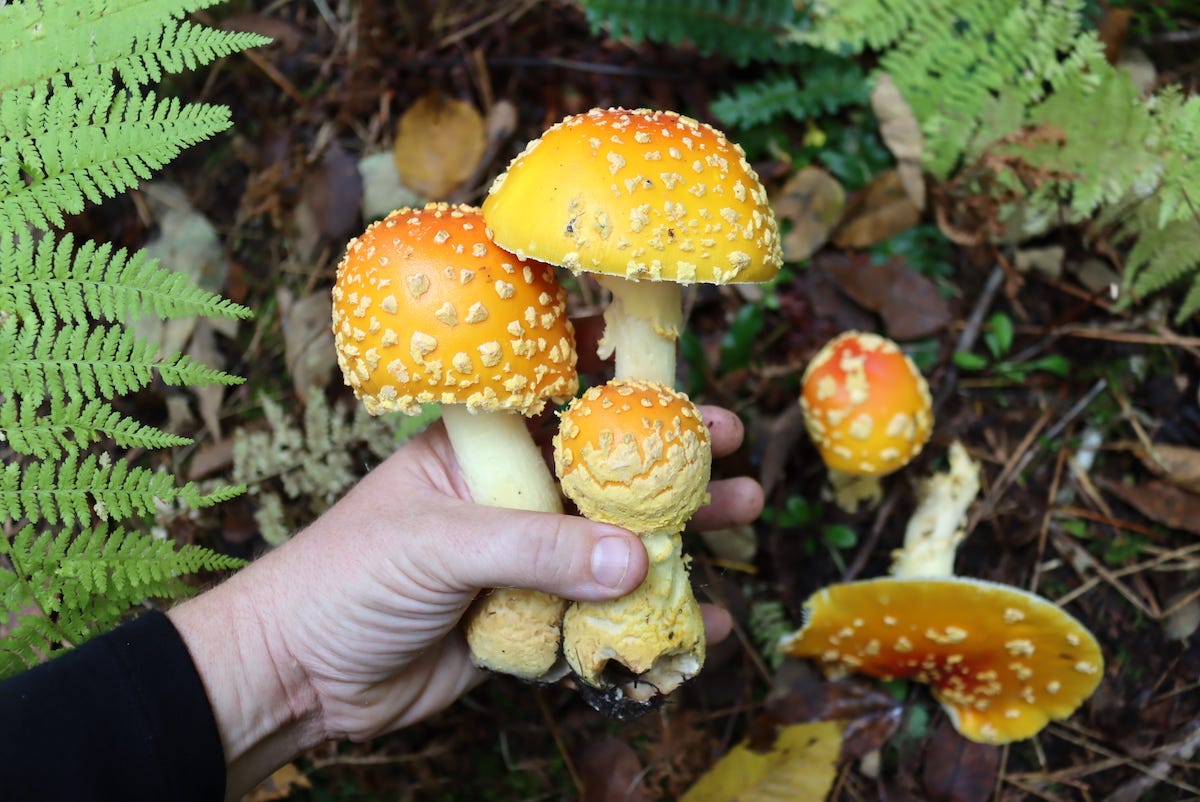Late October 2022| Practical Self Reliance
Fall Mushroom Foraging, Meal Canning & The Season of Eating Well
By mid-to-late October, we’ve entered what I like to call “the season of eating well.”
Sure, it’s almost “the holidays,” but I’m not talking about pumpkin pies and christmas dinners. I’m talking about slow cooked, deeply nourishing meals.
Summer is all about sweet/tart fruits, fresh salads, and a frenetic pace as we run from the garden, to the beach, to a mountain hiking trail…barely pausing to take a breath and just be.
While others seem to hate this change of seasons, and the impending cold weather, I revel in it.
So begins the season of eating well.

At this point, many of my favorite veggies are still readily available out in the garden. We have all the cold hardy vegetables like beets, arugula, brussels sprouts, scallions, chives, cillantro and many more.
Plenty to add flavor and color to our heavy cold weather dishes…
Things like roast duck and goose, long simmered mutton chunks, rich bone broths, and more fall mushrooms than you can shake a stick at.

This week, we made a duck and hen of the wood pizza that was truly excellent, but hen of the woods are also lovely in s simple preparation as a mushroom steak (in this case, fried in duck fat).
Cooking with animal fat adds incredible depth of flavor to foods, and browns vegetables and mushrooms much better than vegetable oils.
Even if you’re not looking at the nutritional benefits of free range grass fed animal fats, the flavor alone is enough to convert most people (once you give them a try).
Out in the woods, late October is bursting with some of the tastiest mushrooms, but also many medicinals. In the past few weeks, I’ve found mostly medicinal mushrooms, as well as types I consider ornamental (fun finds, but ones I don’t use personally).
This year, I’ve seen more chaga fungus than ever before, and marked the places in my mind for later (as they’re a mushroom best harvested in winter). Chaga is a parasite on birch trees, and it will eventually kill the tree…but in the meantime the tree and mushroom both produce compounds to battle it out, trying to outwit eachother in a biological arms race.
Those same compounds also happen to have incredible medicinal benefits for humans.
The trees themselves are medicinal, as well as just about every mushroom that grows on birch (including not only chaga, but also birch polypore and tinder polypore). They’ve been used by humans going all the way back to pre-history, and they were used by neaderthals before we were even technically “human.”
Their war has been fought beneath the bark for literally millions of years, and seldom gets noticed by passers by…but it leaves miraculous medicine from both wood and myclillum in its wake.
Besides chaga, it’s also been a record year for Amanita mushrooms, which while beautiful, they’re not something we use.
This time of year, the woods are literally carpeted with them in some places, and you’ll probably recognize their colorful spotted caps from literature (Alice in wonderland, and other places).
They too have been used by humans since antiquity, and it’s thought that many of the Holiday myths from October through December come from this special genus of mushrooms.
Reindeer are famous for eating them, and in the right dosage and preparation, they give a sensation of flying, and redden the face…giving rise to a jolly man in a suit being pulled by flying reindeer.
The best known species is amanita muscaria, which has a bright red cap with white spots. Its still collected and dried to decorate Christmas trees in many parts of the world, and it’s one of the reasons we associate the colors red, white and green with this time of year.
Our woods are carpeted with a closely related species, Amanita flavoconia, which has a more yellow/orange color under the white spots.
There are many people that use these mushrooms medicinally and spiritually, but I’m not one of them, so I can’t help you here if you have questions. (They can also be incredibly toxic, even in very small doses…so not worth it in my book.)
None the less, mushrooms are fun to spot even if you’re not using them. I think of it like going bird watching…it’s not less fun just because you’re not physically bringing the robin home with you (beyond in a memory).
This time of year, we are harvesting plenty of winecaps and puffballs, mostly from the wood chips on the walking paths in our garden. Wood chip gardening not only keeps the weeds down, it also nourishes living soil and gives you a periodic harvest of mushrooms too.

In the kitchen, we’ve been working on recipe development, not only with the abundance of wild mushrooms this fall, but also with all manner of other seasonal foods.
It is the season of eating well, after all.
Beyond eating well “now” we also try to use this time to prepare foods for the following year, so we’re not just coming in hungry and without optious next summer, when the garden and pasture keep us busy until past 9pm.
A few canned meals in a jar mean that we can have a real home cooked meal, but fast and without much effort in the moment. True, it requires effort months before to prepare and put up the food, but I’m ever thankful for it on a busy summer night.
One new recipe I’m particularly happy with is canned Thai red curry duck. Thai food is delicious, and surprisingly easy to prepare at home. You feel like you’re having a fancy restaurant meal, but you haven’t left home.
I’m hoping to develop similar canning recipes for our other ethnic staples, like chicken korma and lamb vindaloo. Soon!
Beyond the canner, our freeze dryer has also been hard at work preserving full meals for next year. At this point, every dinner is a double batch and the second half of it goes into the freeze dryer.
It’s the same amount of effort now, but I get twice as many meals cooked and put away for later.
While the bulk of harvest season is past, there’s still pleny of our garden produce to process and preserve. I have buckets of green tomatoes and tomatillos for canning, and I also have plenty of husk cherries.
They’re an old fashioned fruit that’s discussed a good bit in The Little House on the Prarie books, either stored and eaten fresh, or made into husk cherry jam.
It’s basically a sweet little flavor bomb that tastes like a cross between a strawberry and a pineapple, but comes wrapped in a papery husk, from a plant that looks a lot like a tomato plant (or exactly like a tomatillo plant).
They’re increidbly prolific, and back in the day they were a quick way to get fresh fruit in a single season (rather than waiting years or decades for full sized fruit trees to mature and bare).
Left in the husk, the fruits will keep until February, even at room temperature.
I still have some in husk for storage, but the ones below were harevested in a rush on the last day before our first frost (about a month ago). I literally raked them off the ground into buckets as I pulled the plants, so they got a bit bruised and won’t keep beyond 4-6 weeks.
I’ve husked them out, and they went into husk cherry pie and wine this week. The pie was incredible, and I have high hopes for the wine. Nothing beats the option to grow your own tropical flavor up here in the north.
What are you harvesting, preserving, building or exploring on your homestead this week? I’d love to hear about it!
Leave me a note in the comments…
(Comments only, please. Emails tend to get lost in my inbox, and as much as I’d love to get back to each and everyone, my screen time is very limited…and things fall through the cracks, and emails get buried in my inbox. If you comment here, they’re all in one place, and it’s much easier to get back to every single one.)
Until Next Time,
Ashley at Practical Self Reliance








I recently made and canned beef Shawarma (a middle eastern staple) with ground beef that came out remarkably well. I followed your post for canning ground beef, adding chopped onion, a healthy amount of garlic, and shawarma spices. The fat cap In the jar provided the perfect fry medium to crisp-up the beef. By the time I whipped-up the hummus, the shawarma was ready to spoon on top of it.
Thanks again for your posts!
Hi Ashley.
I picked up your column quite a few months ago. I sold my house with 4 acres in the city about 3 years ago and moved into an apartment. I was having trouble getting around and had cared for my wife a long time who died in 2015. We did lots of things before she got sick. I had planted asparagus, rhubarb, June berries, raspberries, and lots of other things like apple trees, blueberry bushes grapes, etc.
One of the best investment we made a long time ago was a steamer juicer.
I lived in apartments for 2 1/2 years and being on the north side of the apartment it was difficult growing anything on the balcony. In September of last year my girl friend and I started to look for a house with acreage. that was difficult finding something as most people were willing to pay well over market value for anything available.
We did close on a place with 12 1/2 acres the end of June and a month later we were married in our own house by her son. Pretty scary for an 80 year young man and a 75 year young lady. I planted some field peas near the end of June plus some buckwheat. The peas were just blooming and they still are in this cold weather. I did pick a couple pounds of the bucjwheat. Not sure if I want to gring it into flour or reseed it next year earlier.
My wife's (Terry) granddaughter who is 10 was here and we picked a bunch of the wild plums. Most of them were purple but found red ones later. We canned and froze the juice for making jelly later.
I have lots going on and my energy runs down a little earlier in the day than it used to.
I also have at least 20wild apple trees growing here. I did make desserts out of some of the crabapples. I have at least 3 varieties. I am guessing somebody deer hunted here years ago and just throw his apple cores away.